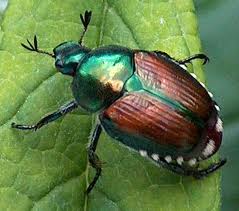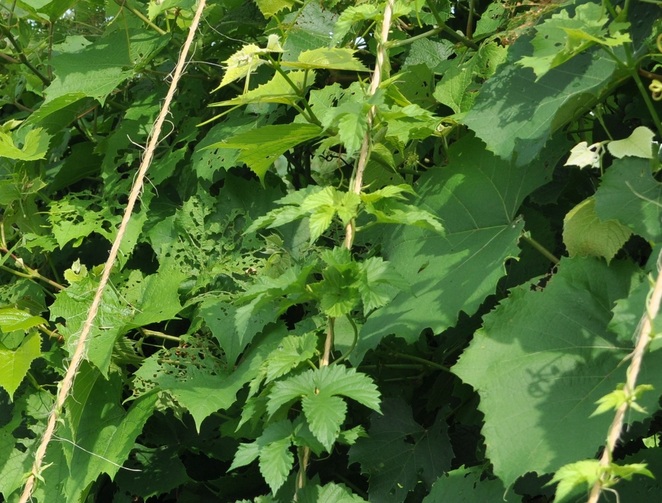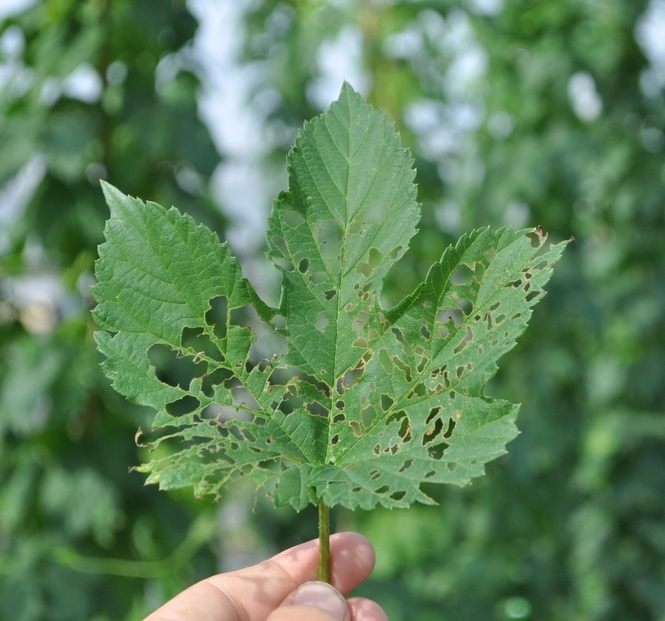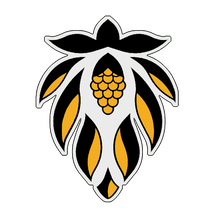 Japanese beetles are proving to be a formidable foe in hop yards located in the Great Lakes region. The beetles can cause significant damage to hop foliage and bines in a very short period of time if left uncontrolled. Two beetles can strip a large hop leaf in a single day and when their numbers reach the thousands, the beetles can strip a hop yard in just a few days. Organic hop growers find controlling them especially frustrating because they cannot apply the synthetic chemical controls commonly utilized. Here are some control strategy tips for all hop growers – organic and non-organic. First concept: Beetles attract more beetles. I do not consider Japanese beetles to be a threshold control-type pest where the decision to spray is based on tolerating a certain level of pests before treatment or spraying is done. Female beetles excrete pheromones to attract males and mating is a gregarious affair – a “beetle orgy” for lack of a better term. Beetles fly into the wind and follow the beetle pheromone trail to the plants and leaves where feeding and mating occur. Females apparently leave pheromones on the leaves; as I note that beetles arrive and continue to congregate on the same leaves – even if the original beetles are removed. However, a good hard rainfall seems to wash away this residual pheromone trail. It is well known that hanging pheromone traps can attract large number of both male and female beetle from great distances. A population of mating beetles will grow exponentially as congregating beetles emit stronger pheromone trails for newcomers to follow to the orgy – just like a pheromone trap. Allowing the beetles to establish a population in a hop yard is exactly like hanging pheromone traps in the middle of your hop yard. Controls & Strategies: Knockdown Chemical control. Traditional spraying with chemicals such as bifenthrins or pyrethroids are all commonly used to control adult beetles on hops. Organic growers have to be a bit more creative since this is not an option in their hop yards. Spraying with products like Impede, Trilogy, or SurroundWP may be options for organic growers to consider. The insecticides containing bifenthrin, imidacloprid, or other pyrethriods are no longer my favored first control choice because I found using them caused a flare of increased populations of spider mites a few weeks later. There are several other ways to reduce the damage caused by beetles. Using some or all of these strategies can help keep populations of the beetles under control for all hop growers.
 Pictured above: Grapes used as a trap plant, distracting beetles from the nearby hops.
Combining all of these strategies can help control this damaging pest.  Pictured above: The damage a pair of beetles can do in just 24 hours. |
Details
Blog AuthorLynn, the head hop grower at Great Lakes Hops has over 30 years of experience in the horticultural field. Browse the blog articles here to find useful growing information for humulus lupulus, based on personal experience and observations at Great Lakes Hops. Archives
January 2020
Categories
All
|


 RSS Feed
RSS Feed